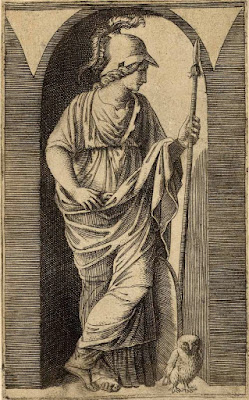 |
| Sébastien Leclerc Initial M with Minerva ca. 1696 etching, letterpress British Museum |
 |
| Sébastien Leclerc Initial M with Minerva ca. 1675 etching, letterpress British Museum |
MINERVA - The Italian goddess of intelligence, meditation and inventiveness, queen of all accomplishments and arts, especially of spinning and weaving, as practiced by women. She was also the patron-goddess of fullers, dyers, cobblers, carpenters, musicians, sculptors, painters, physicians, actors, poets, schoolmasters, and especially of schoolchildren. Her oldest and most important sanctuaries were at Rome on the hills of the town; on the Capitol, where she occupied a chamber on the right in the great temple common to her with Jupiter and Juno; on the Aventine, where the official meeting place of poets and actors was situated, and on the Caelian. Her chief festival was the Quinquatrus. In the course of time the Greek conception gained more ground; Minerva was identified with Pallas Athena. This certainly happened with regard to Athena considered as the bestower of victory and booty, when Pompey erected a temple to her from the booty won in his Eastern campaigns. And Augustus must have regarded her as Athena the Counselor when he added to his Curia Iulia a vestibule dedicated to Minerva. The Roman Minerva was represented in art in the same manner as the Greek goddess.
– from The Dictionary of Classical Mythology, Religion, Literature, and Art by Oskar Seyffert, first published in German in 1882, first published in English in 1891
 |
| Peter Paul Rubens Head of Minerva (derived from a coin or gem) ca. 1600-1608 drawing British Museum |
 |
| Anonymous Italian Gem-cutter Intaglio - Minerva 18th century sard British Museum |
 |
| James Tassie or William Tassie Intaglio - Minerva ca. 1765-1860 glass imitating amethyst British Museum |
 |
| Étienne Delaune Minerva 1569 engraving British Museum |
 |
| Philips Galle after Johannes Stradanus Juno, Minerva, Venus awaiting Judgment of Paris ca. 1580-90 engraving British Museum |
 |
| Raffaellino da Reggio Hercules, Minerva and Mars ca. 1545-78 drawing (study for façade mural) British Museum |
 |
| Claude Lorrain Scene on Parnassus with Minerva visiting the Muses 1676 drawing British Museum |
 |
| Louis-Jacques Durameau Minerva inscribing a shield supported by Fame ca. 1733-96 drawing British Museum |
 |
| Marcantonio after Raphael Minerva in niche ca. 1511-1520 engraving (from sarcophagus relief) British Museum |
 |
| Marcantonio Reconciliation beteween Minerva and Cupid ca. 1517-20 engraving British Museum |
 |
| Antoine Rivalz Personification of Painting attended by Spirits of the Arts and conversing with Minerva ca. 1695-99 engraving British Museum |
 |
| Abraham Bosse Minerva guides the hand of the artist 1642 etching British Museum |